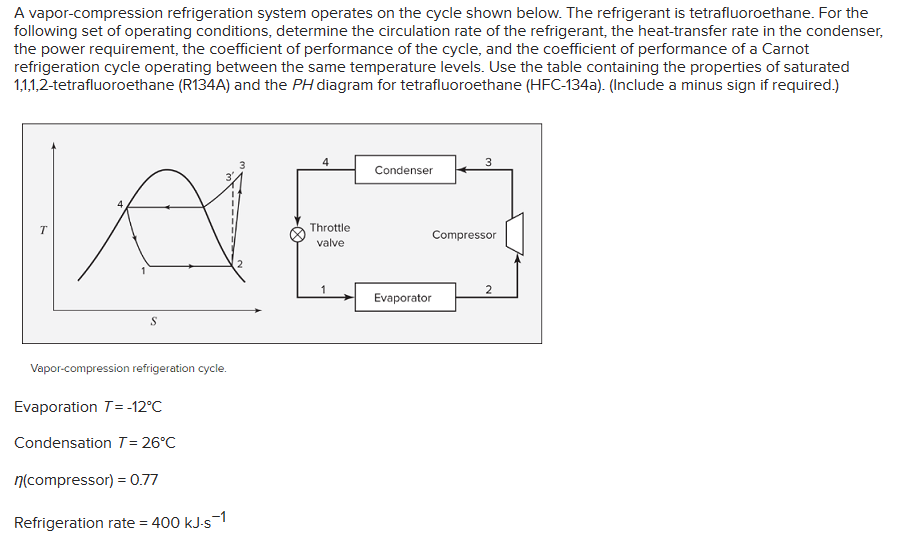A vapor-compression refrigeration system operates on the cycle shown below. The refrigerant is tetrafluoroethane. For the following set of operating conditions, determine the circulation rate of the refrigerant, the heat-transfer rate in the condenser, the power requirement, the coefficient of performance of the cycle, and the coefficient of performance of a Carnot refrigeration cycle operating between the same temperature levels. Use the table containing the properties of saturated 1,1,1,2-tetrafluoroethane (R134A) and the PH diagram for tetrafluoroethane (HFC-134a). (Include a minus sign if required.)
A vapor-compression refrigeration system operates on the cycle shown below. The refrigerant is tetrafluoroethane. For the following set of operating conditions, determine the circulation rate of the refrigerant, the heat-transfer rate in the condenser, the power requirement, the coefficient of performance of the cycle, and the coefficient of performance of a Carnot refrigeration cycle operating between the same temperature levels. Use the table containing the properties of saturated 1,1,1,2-tetrafluoroethane (R134A) and the PH diagram for tetrafluoroethane (HFC-134a). (Include a minus sign if required.)
Refrigeration and Air Conditioning Technology (MindTap Course List)
8th Edition
ISBN:9781305578296
Author:John Tomczyk, Eugene Silberstein, Bill Whitman, Bill Johnson
Publisher:John Tomczyk, Eugene Silberstein, Bill Whitman, Bill Johnson
Chapter22: Condensers
Section: Chapter Questions
Problem 7RQ: When a standard-efficiency air-cooled condenser is used, the condensing refrigerant will normally be...
Related questions
Question

Transcribed Image Text:A vapor-compression refrigeration system operates on the cycle shown below. The refrigerant is tetrafluoroethane. For the
following set of operating conditions, determine the circulation rate of the refrigerant, the heat-transfer rate in the condenser,
the power requirement, the coefficient of performance of the cycle, and the coefficient of performance of a Carnot
refrigeration cycle operating between the same temperature levels. Use the table containing the properties of saturated
1,1,1,2-tetrafluoroethane (R134A) and the PH diagram for tetrafluoroethane (HFC-134a). (Include a minus sign if required.)
T
S
Vapor-compression refrigeration cycle.
Evaporation T= -12°C
Condensation T = 26°C
n(compressor) = 0.77
Refrigeration rate = 400 kJ-s¯1
4
Throttle
valve
Condenser
3
Compressor
Evaporator
2

Transcribed Image Text:The coefficient of performance
The coefficient of performance
of the cycle is
of a Carnot refrigeration cycle operating between the same temperature levels is
Expert Solution
This question has been solved!
Explore an expertly crafted, step-by-step solution for a thorough understanding of key concepts.
This is a popular solution!
Trending now
This is a popular solution!
Step by step
Solved in 6 steps with 5 images

Knowledge Booster
Learn more about
Need a deep-dive on the concept behind this application? Look no further. Learn more about this topic, mechanical-engineering and related others by exploring similar questions and additional content below.Recommended textbooks for you

Refrigeration and Air Conditioning Technology (Mi…
Mechanical Engineering
ISBN:
9781305578296
Author:
John Tomczyk, Eugene Silberstein, Bill Whitman, Bill Johnson
Publisher:
Cengage Learning

Refrigeration and Air Conditioning Technology (Mi…
Mechanical Engineering
ISBN:
9781305578296
Author:
John Tomczyk, Eugene Silberstein, Bill Whitman, Bill Johnson
Publisher:
Cengage Learning